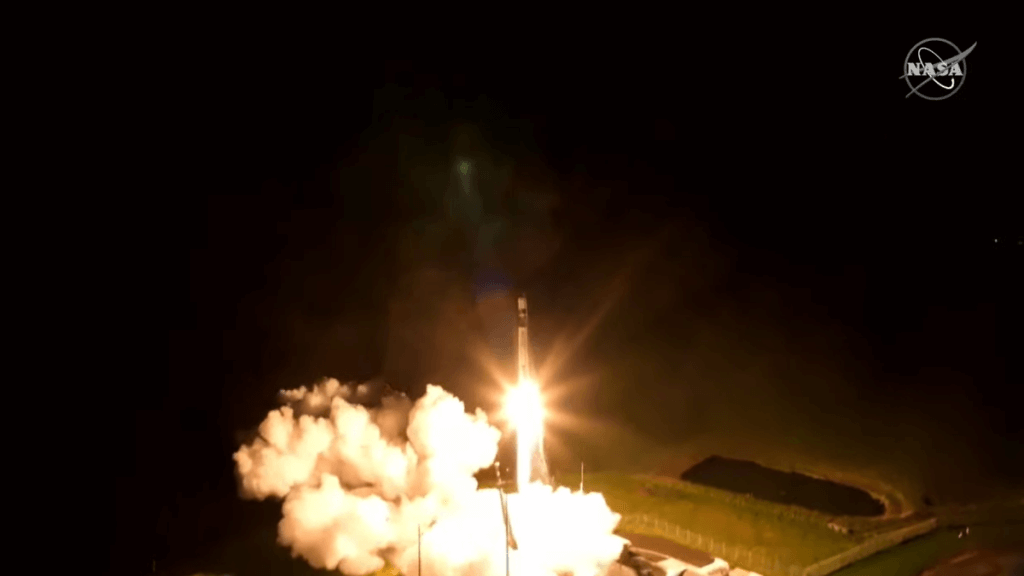NASA’s tiny CAPSTONE spacecraft has begun its long, history-making journey to the moon.
The 55-pound (25 kilograms) cubesat launched today (June 28) atop a Rocket Lab Electron booster, which lifted off from the company’s Launch Complex 1 on the Māhia Peninsula of New Zealand at 5:55 a.m. EDT (0955 GMT; 9:55 p.m. local time in New Zealand).
“The launch was absolutely fantastic,” said Bradley Smith, NASA’s director for Launch Services Office, who was on hand for the nighttime moonshot.
CAPSTONE is headed for the moon, where it will test the stability of the orbit that NASA plans to use for its Gateway space outpost. But it’ll be a while before CAPSTONE reaches its destination.
Related: NASA’s CAPSTONE moon mission to go where no cubesat has gone before
A circuitous journey
The Apollo missions made it to the moon in about three days. But those famous spacecraft were blasted off Earth by NASA’s Saturn V rocket, the most powerful booster ever to fly.
The microwave-oven-sized CAPSTONE (short for “Cislunar Autonomous Positioning System Technology Operations and Navigation Experiment”), by contrast, left our planet aboard the 59-foot-tall (18 meter) Electron, which is designed to send small satellites to Earth orbit. So CAPSTONE is taking the scenic route.
CAPSTONE is a payload aboard Photon, Rocket Lab’s spacecraft bus, which was integrated into the two-stage Electron’s upper stage. About nine minutes after launch today, Photon and CAPSTONE separated from the upper stage into low Earth orbit.
“Perfect Electron launch!” Rocket Lab CEO Peter Beck wrote in a update on Twitter (opens in new tab). “Lunar photon is in Low Earth Orbit.”
Over the next five days, Photon will gradually boost its orbit via a series of engine burns. Six days after launch, Photon will perform one final burn, which will increase its velocity to 24,500 mph (39,500 kph) — fast enough to escape Earth orbit and head for the moon. Within 20 minutes of that burn, Photon will deploy CAPSTONE, Rocket Lab representatives wrote in a mission press kit, which you can find here (opens in new tab).
CAPSTONE will fire its own thrusters occasionally over the next few months, keeping it on an efficient, low-energy trajectory toward the moon. The cubesat’s path will take it as much as 810,000 miles (1.3 million kilometers) from Earth — more than three times the Earth-moon distance — before gravity pulls it back.
Finally, on Nov. 13, CAPSTONE will insert itself into a near rectilinear halo orbit (NRHO) around the moon, an intriguing but untested spot in space. The $30 million mission is led for NASA by the Colorado-based Advanced Space.
Related: NASA’s CAPSTONE moon mission to go where no cubesat has gone before
Paving the way for Gateway
The NRHO will take CAPSTONE within 1,000 miles (1,600 km) of one lunar pole on its closest pass and 43,500 miles (70,000 km) from the other pole at its most distant point.
Mission engineers expect this orbit to be highly stable: Spacecraft shouldn’t have to burn much fuel to stay in the NRHO, thanks to the balancing gravitational pulls of the moon and Earth, researchers say. This is one of the main reasons that NASA has tapped it for the Gateway space station, a key part of the agency’s Artemis program of lunar exploration. Gateway will serve as a jumping-off point for sorties, both crewed and uncrewed, to the lunar surface. NASA aims to launch the core elements of the small moon-orbiting outpost in late 2024.
But no spacecraft has ever occupied a lunar NRHO before, so assumptions about its stability are just that — assumptions. And that’s where CAPSTONE comes in. The cubesat will spend at least six months in the NRHO, assessing its characteristics.
“The reason we’re in this orbit is it’s incredibly stable, but also relatively close to the moon,” said Nujoud Merancy, NASA’s chief of the exploration mission planning office at the Johnson Space Center in Houston, in a video aired during NASA’s launch webcast.
With CAPSTONE as the sort of pathfinder, it can demonstrate the navigation, the guidance, the propulsive capability to maintain the orbit, and we can really just extract from that the math to validate the orbits for Gateway, Orion and Artemis missions,” Merancy said.
The CAPSTONE mission “will also demonstrate innovative navigation solutions, including spacecraft-to-spacecraft navigation and one-way ranging capabilities with Earth ground stations,” according to a Rocket Lab press kit.
The spacecraft-to-spacecraft tests will be performed in tandem with NASA’s Lunar Reconnaissance Orbiter, which has been circling the moon since 2009.
Private companies exploring deep space
CAPSTONE is a huge milestone for Rocket Lab, which had never before launched a deep-space mission. But Rocket Lab will send other missions far afield in the near future, if all goes according to plan; the California-based company aims to launch at least one life-hunting mission to Venus using Electron and Photon in the next few years.
And CAPSTONE is blazing a trail for private spaceflight in other ways as well. Colorado-based company Advanced Space developed the mission and will operate it, having won a $20 million NASA contract to do so.
Other commercial outfits are involved as well. Two California companies — Terran Orbital Corp. of Irvine and Stellar Exploration, Inc. of San Luis Obispo — built the CAPSTONE cubesat and provided its propulsion system, respectively. And Rocket Lab, of course, sent the mission on its way to the moon.
CAPSTONE was originally scheduled to launch in May, but the liftoff was pushed back multiple times for systems checks and other tests.
Mike Wall is the author of “Out There (opens in new tab)” (Grand Central Publishing, 2018; illustrated by Karl Tate), a book about the search for alien life. Follow him on Twitter @michaeldwall (opens in new tab). Follow us on Twitter @Spacedotcom (opens in new tab) or on Facebook (opens in new tab).

